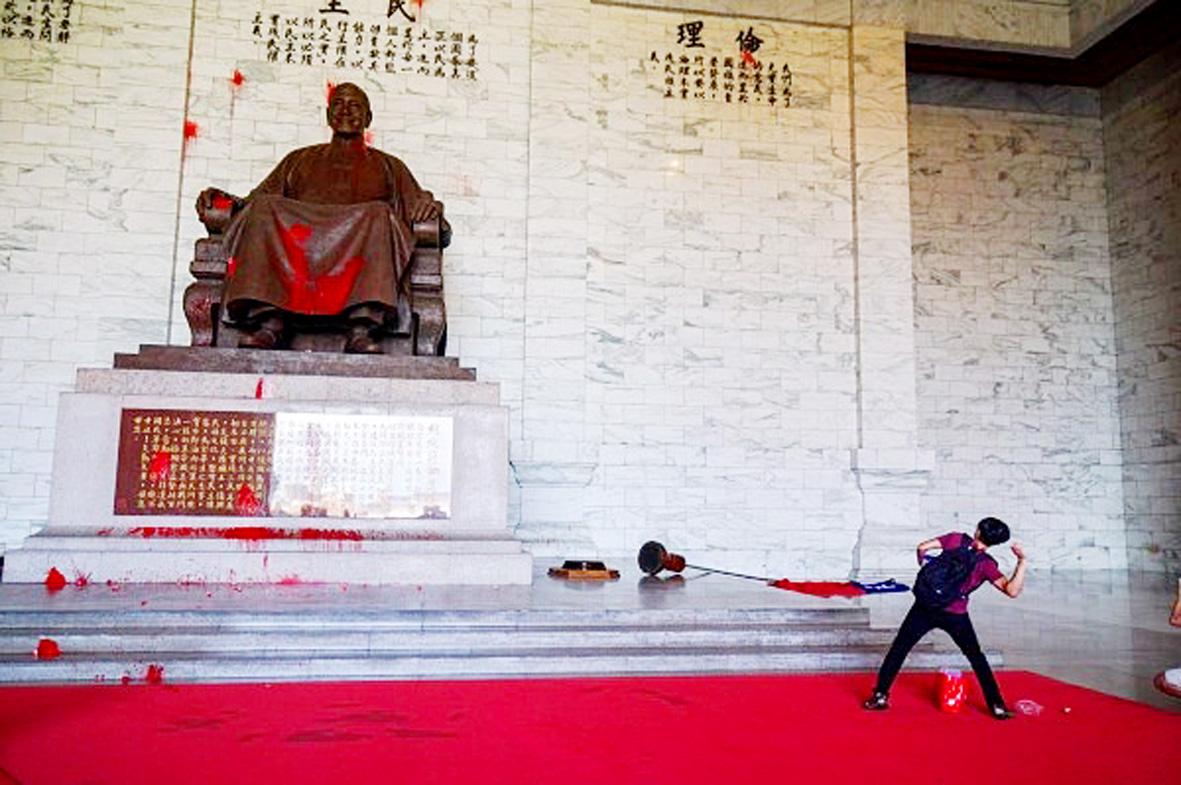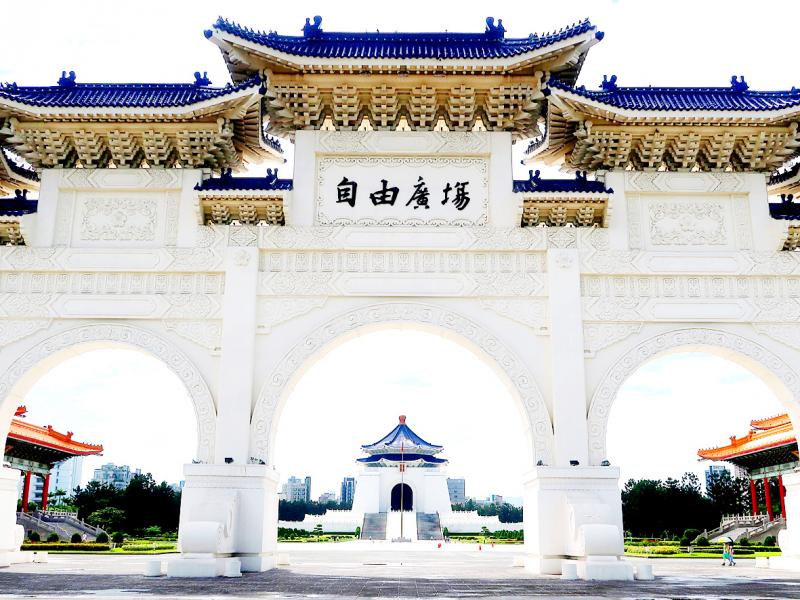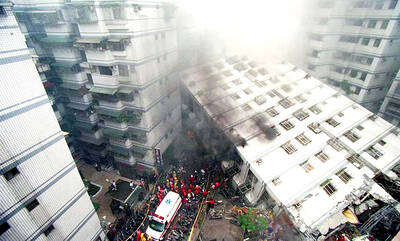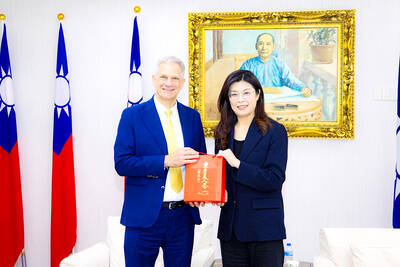Last week the Transitional Justice Commission proposed taking down the statue of Chang Kai-shek (蔣介石) at Chiang Kai-shek Memorial Hall in central Taipei. It depicted the move as part of a plan for excising markers of authoritarianism from the park.
The most important task, the commission said, would be removing the hall’s “axis of worship,” the 6.3m-tall bronze statue of Chiang.
Let us hope that if and when that obscenity is finally removed from the memorial, it is placed in the famed Cihu Memorial Sculpture Garden in Taoyuan’s Dasi District (大溪), where it can be properly mocked for all eternity.

Photo: Chen Yu-fu, Liberty Times
CHIANG, CHIANG, EVERYWHERE
Removing markers of the authoritarian era should start, of course, with names. Chiang’s personality cult, recounted in Jeremy Taylor’s “The Production of the Chiang Kai-shek Personality Cult, 1929–1975” (China Quarterly, 2006), remains stamped across Taiwan’s physical and political spaces, like a ranch brand on cattle.
Almost all the nation’s cities host a Zhongzheng Road (中正路), named after Chiang. Keelung and Taipei boast Zhongzheng (中正) districts. No mere indicators of Chiang’s power, these names from China are markers of a colonial regime that reshaped the island’s life to its own ends.

Photo: Chen Yu-fu, Liberty Times
Visitors often wonder why the street names haven’t been changed. For a street name change, under the law, a vote must be held by the individuals owning addresses on the street. Since few people will vote to undertake changing every piece of paper that defines their lives, perhaps reviving old property disputes and certainly necessitating scores of encounters with Taiwan’s bureaucracy, changing street names is almost impossible.
Thus the ancien regime remains a current presence.
Another signifier of Chinese Nationalist Party (KMT) power that needs to be scrubbed is place names in the mountains. Taiwan’s Aboriginal areas are marked with silly names relating to rebuilding the Republic of China (ROC) or “peace,” as if invoking sympathetic magic to keep the locals from rebelling against authoritarian power. The legislature needs to get moving on reverting all of those to place names used by the local indigenous peoples.
While they’re at it, our politicians should at least consider the idea of removing words like fan (番), “savage,” from place names across Taiwan. KMT colonialism, after all, is simply a subset of Han settler colonialism. The two must be addressed together.
It goes without saying that government and government-owned entities with the word “China” in their names need rectified.
VESTIGES OF AUTHORITARIANISM
Cleaning the veneer of authoritarian power is only the beginning. Too many of Taiwan’s organizations and structures retain the frameworks of authoritarian power, making them dangerously easy to revert.
For example, the educational system, in many ways still a relic of the authoritarian era, needs massive changes. The idea that students are in a “class” for years with the same students, originally a way to make surveillance more convenient, should be done away with.
The struggle over the Chiang statue and the status of the Hall, which has waxed and waned since the administration of president Chen Shui-bian (陳水扁) changed the name of the memorial, is often depicted as a conflict over the legacy of authoritarianism in Taiwan, but it is much less than that.
This “debate” is, rather, a noisy avoidance of that conflict, a sign that KMT leaders have won the real fight.
CHIANG CHING-KUO’S LEGACY
What is the function of all this talk? The Chiang statues are endlessly discussed, obscuring the silence about markers and memorials relating to Chiang Ching-kuo (蔣經國), his brutal but far more competent son. As I have noted elsewhere, the popularity of the younger Chiang functions as a kind of psychic compensation for the absurd and groundless veneration of the father, Ching-kuo being the Chiang that, in today’s society, it is okay to admire.
Other markers of authoritarian power, such as statues to politicians who lived out their lives in China — who is ROC President Lin Sen (林森) to Taiwan history? — remain almost a non-issue. The numerous ROC martyr’s shrines live on, undisturbed.
Like the innumerable Confederate monuments in the US, they are victory markers, memorializing the triumph of colonial power over local democracy even in the face of military defeat. The KMT may have lost the war in China, but it won the peace in Taiwan: it obliterated Japanese colonial markers and suppressed the island’s democracy.
The function of the Chiang statue debate is not to clarify, but to occlude. It gives the green camp a way to look like it is sticking it to the pro-China side, while the pro-China side can rally its base. In today’s politics, that’s what passes for a win-win situation.
Indeed, KMT Chairman Johnny Chiang (江啟臣) went to town on the proposal, saying of President Tsai Ing-wen (蔡英文): “She is not only an authoritarian leader over a one-party state, but also an admitted publicly elected dictator… Does she not need to reflect on herself? Stepping down is better than tearing down statues.”
The semiannual ritual debate over the statue is a case of justice delayed. Of justice denied.
The commission has laudably released documents from the White Terror era. It has exonerated many imprisoned and killed for political reasons by the regime (did anyone think they were guilty of a crime?). It has embarrassed the KMT. These are good things.
Yet, it is 2021. Not a single person has been punished for the thousands of dead, for those tortured and imprisoned and exiled, for the five decades of authoritarian control. Instead, we are talking about a statue that should have been banished two decades ago. Our democratic transition remains, as Naiteh Wu (吳乃德) wrote in 2005, a transition without justice.
The dead cry out for justice. Still.
Notes from Central Taiwan is a column written by long-term resident Michael Turton, who provides incisive commentary informed by three decades of living in and writing about his adoptive country. The views expressed here are his own.

Seven hundred job applications. One interview. Marco Mascaro arrived in Taiwan last year with a PhD in engineering physics and years of experience at a European research center. He thought his Gold Card would guarantee him a foothold in Taiwan’s job market. “It’s marketed as if Taiwan really needs you,” the 33-year-old Italian says. “The reality is that companies here don’t really need us.” The Employment Gold Card was designed to fix Taiwan’s labor shortage by offering foreign professionals a combined resident visa and open work permit valid for three years. But for many, like Mascaro, the welcome mat ends at the door. A

Last week gave us the droll little comedy of People’s Republic of China’s (PRC) consul general in Osaka posting a threat on X in response to Japanese Prime Minister Sanae Takaichi saying to the Diet that a Chinese attack on Taiwan may be an “existential threat” to Japan. That would allow Japanese Self Defence Forces to respond militarily. The PRC representative then said that if a “filthy neck sticks itself in uninvited, we will cut it off without a moment’s hesitation. Are you prepared for that?” This was widely, and probably deliberately, construed as a threat to behead Takaichi, though it

If China attacks, will Taiwanese be willing to fight? Analysts of certain types obsess over questions like this, especially military analysts and those with an ax to grind as to whether Taiwan is worth defending, or should be cut loose to appease Beijing. Fellow columnist Michael Turton in “Notes from Central Taiwan: Willing to fight for the homeland” (Nov. 6, page 12) provides a superb analysis of this topic, how it is used and manipulated to political ends and what the underlying data shows. The problem is that most analysis is centered around polling data, which as Turton observes, “many of these

Since Cheng Li-wun (鄭麗文) was elected Chinese Nationalist Party (KMT) chair on Oct. 18, she has become a polarizing figure. Her supporters see her as a firebrand critic of the ruling Democratic Progressive Party (DPP), while others, including some in her own party, have charged that she is Chinese President Xi Jinping’s (習近平) preferred candidate and that her election was possibly supported by the Chinese Communist Party’s (CPP) unit for political warfare and international influence, the “united front.” Indeed, Xi quickly congratulated Cheng upon her election. The 55-year-old former lawmaker and ex-talk show host, who was sworn in on Nov.